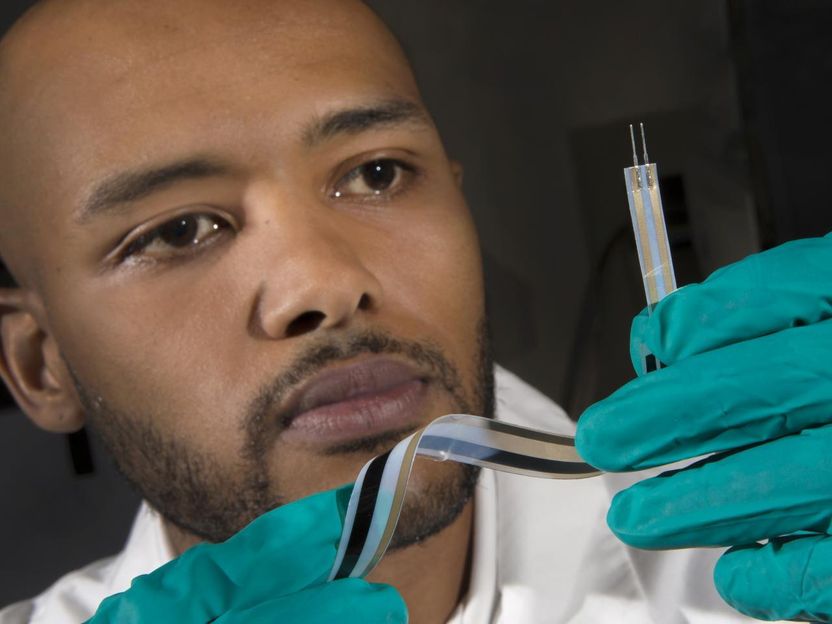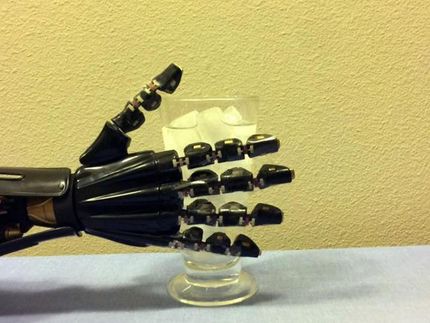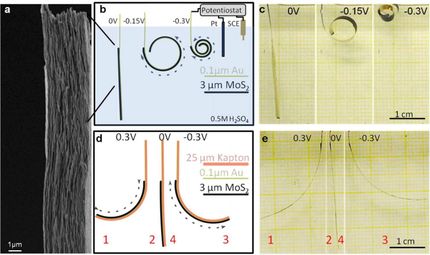Motion sensors leap major step toward low-cost, high-performance wearable technology
Researchers from the FAMU-FSU College of engineering have developed a class of breakthrough motion sensors that could herald a near future of ubiquitous, fully integrated and affordable wearable technology.

FAMU-FSU College of Engineering doctoral candidate Joshua DeGraff developed an advanced class of scalable motion sensors using silver ink electrodes and sheets of pure carbon nanotube buckypaper.
FSU Photography Services
Engineers from FSU's High-Performance Materials Institute, in collaboration with scientists from Institut National des Sciences Appliquées in Lyon, France, detail the impressive properties and cost-effective manufacturing process of an advanced series of motion sensors made using buckypaper -- razor thin, flexible sheets of pure, exceptionally durable carbon nanotubes.
These new buckypaper sensors represent a marked improvement on current industry standards, with most sensors being either too crude or too inflexible to reliably monitor complex structures like the human body.
"Current technology is not designed for that," said Richard Liang, director of the High-Performance Materials Institute and professor at the FAMU-FSU College of Engineering. "For sensor technology, you need it to be flexible, you need it to be affordable and you need it to be scalable. This new technology is versatile and the sensors are affordable to print. It's a big innovation that presents many possibilities down the road."
At this stage, potential applications for the printable buckypaper sensors are limited only by the breadth of researchers' imaginations. The low-profile design could be integrated into bedsheets to monitor quality of sleep, shoes to track step count and posture or workout clothes to measure intensity of exercise.
Researchers also foresee potential applications beyond the realm of wearable technology. In the field of soft robotics, the material could facilitate advances in the production of responsive, self-correcting artificial muscles.
Moreover, the scalable sensors represent another step toward the long-predicted future of an "internet of things," where virtually all of an individual's computers, devices, garments, furniture and appliances are digitally connected to freely exchange information in the cloud.
"Most projects don't have this many possible applications," said doctoral candidate Joshua DeGraff, the lead author of the study. "This material could be used in structural health monitoring, wearable technology and everything in between. I'm excited because this is something that can affect a lot of people in their everyday lives."
The novel sensor structure combines a strip of seven micron-thin buckypaper with silver ink electrodes printed from a common, commercially available ink-jet printer.
The result is a kind of perfect Goldilocks sensor: not as insensitive as common, flexible metallic sensors, but not as rigid or cumbersome as popular, more sensitive semi-conductor sensors.
The wearable buckypaper sensors are an ideal marriage of these competing qualities. They're flexible, seamless and sensitive to subtle movements and strains.
"We measure sensors by gauge factor, which indicates how much resistance value changes as a material is strained or bent," DeGraff said. "Our gauge factor has been up to eight times higher than commercial sensors and 75 percent higher than many other carbon nanotube sensors."
As development of the printable sensor technology continues, researchers hope to improve upon the already remarkable thinness of the material so that it can be integrated into comfortable and non restrictive clothing.
Additional testing on complex model structures is required to ensure the material's ability to conform to the variable curves and crevices of the human body.
While the technology might not be ready for primetime quite yet, researchers are energized by its promising future.
"As engineering professors, we want to see the things we create in the lab become successful products," Liang said. "We're not quite there yet, but this is an important step. Consumers want great quality and affordable prices, and this material provides both of those things."
Original publication
Other news from the department science
These products might interest you
Most read news
More news from our other portals
See the theme worlds for related content
Topic world Sensor technology
Sensor technology has revolutionized the chemical industry by providing accurate, timely and reliable data across a wide range of processes. From monitoring critical parameters in production lines to early detection of potential malfunctions or hazards, sensors are the silent sentinels that ensure quality, efficiency and safety.

Topic world Sensor technology
Sensor technology has revolutionized the chemical industry by providing accurate, timely and reliable data across a wide range of processes. From monitoring critical parameters in production lines to early detection of potential malfunctions or hazards, sensors are the silent sentinels that ensure quality, efficiency and safety.

































































